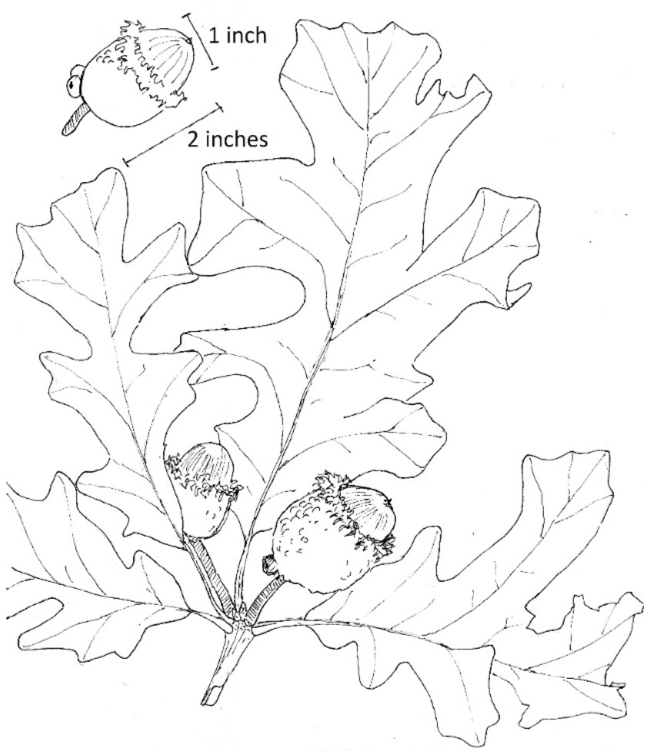The Ozark Plateau is considered to lie in what the Forest Service designates as the oak-hickory biome. Early land office survey data show that Ozark forests were about 70% oak at the time the United States acquired the Louisiana Purchase. The oaks growing on the ridges and cliffs around the Buffalo River come in so many varieties that many of us find it hard to tell one from another. Some like white, black and post oaks are common and widespread, while others are associated with special habitats such as limestone outcrops (chinquapin oak) and poorly drained lowlands (pin oak). Bur oak (Quercus macrocarpa) is a relatively infrequently encountered oak that grows throughout the Ozark region, telling an interesting story about our region’s deep past.
Investigations of the prehistory of Midwest America showed that giant mammals such as mastodons and ground sloths once roamed our region while a great sheet of ice covered almost all of Canada. Investigations at sites where such fossil remains were found showed that the vegetation associated with those fossils was very different from what is found in the Ozarks today. Before the cause of these geologically recent glacial events were known it was sometimes thought that the regions south of the great ice sheets were hardly affected by the coming and going of the northern ice. More recent evidence, however, has shown that the coming and going of ice sheets in the “Ice Age” affected all parts of the globe in a major way. The ability of the atmosphere to absorb and transport water vapor depends on air temperature, so that any cooling of the earth is accompanied by a significantly reduced ability of the atmosphere to transport water. In times of the past, colder times at high latitude corresponded with drier times at lower latitudes. Fossil leaves, pine needles and pollen dated to Ice Age times in the Ozarks provide an idea of what the local scenery was like in those colder and drier times.

Foliage and acorns of bur oak showing the shape and size of the large, leathery leaves and the unusually large acorns with their distinctive fringe of “burs” on the edge of the acorn “cup”.
The most detailed picture of Ice Age climate in the Ozarks is provided by the pollen recovered from Cupola Pond, a small sinkhole in southeastern Missouri. The pollen rain about 20,000 years ago consisted of pine and spruce pollen with a small but consistent amount of oak pollen. Fossil pine needles recovered with a mastodon skeleton in southeastern Kansas shows that the pine was jack pine (Pinus banksiana), a species known to extend as far as the arctic circle in the frigid and dry interior of Canada today. Hardly any oaks ever grow in the company of jack pine where that tree lives at present. So, we question what sort of oak would have been around in Arkansas and Missouri at the height of the Ice Age glacial advances.
Biologists look for modern analogs to fossil pollen assemblies. Sometimes these cannot be found, suggesting that there were once plant associations unlike any around today. But we can find a modern analog for the Ice Age Ozarks in south-central Manitoba along the shores of Lake Winnipeg. Bur oak grows there in the company of jack pine and spruce in a relatively arid climate on the prairie border in an environment too cold and dry for any other oaks, or for other northern hardwoods such as sugar maple and beech. The ability of bur oak to withstand cold and drought is indicated by its presence on the eastern edge of the Rocky Mountains today in Wyoming, and by genetic evidence that it interbred with shrub oaks of Colorado and New Mexico in the past. For these reasons the sporadic occurrence of bur oak in the Ozarks today is evidence of the presence of that tree as the predominant oak species at a time when the local climate was too cold and dry for any other oak species.
Where in our area can we see bur oak today? An easily accessible location (there’s even a paved walking trail) is the city park in Farmington, Arkansas. Several huge, open grown bur oaks are found along the small drainage running beside the central open area in the park. These trees are relicts of the original forest where they grew around the edges of small wet prairies associated with poorly draining soils with clay hardpans impeding drainage. Such prairie edge habitats are where bur oak is often seen in locations farther north such as western Minnesota. But hikers can also find small numbers of bur oak mixed in with the other oaks in locations adjacent to the Buffalo River. They are not common but can be found if you look for them. Two examples are on the upper part of the Cecil Cove Trail a mile or so from the Erbie Road trailhead, and on the west side of Round Mountain along the trail that circles the upper slopes of the mountain where it overlooks the Little Buffalo River near Jasper. Bur oak looks a lot like other oaks, so the best way to find the trees is to look for the distinctive large (hence the Latin name “macrocarpa”) and leathery leaves or the fragments of unusually large acorns (see figure) on the ground along the trail. Searching for the locally rare bur oak is as good an excuse as any for getting out on the trail, as if any such excuse were even necessary.
